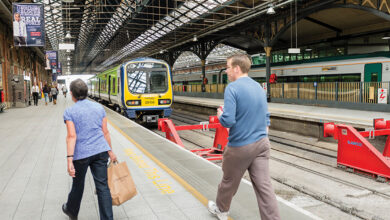Next generation ticketing

The National Transport Authority (NTA) has commenced the initial phase of its next generation ticketing programme through the limited introduction of a pilot mobile ticketing app. The project is aimed at modernising the ticketing experience in the State, evolving the Leap Card system across all public transport networks.
Introduced as a pay-as-you-go, reloadable contactless smart card, the Leap Card was launched in December 2011 by Transport for Ireland (TFI), the consumer facing brand of the NTA. By late 2016, over 2 million cards had been sold and by early 2018, this figure had surpassed 3 million. Today, 80 per cent of all TFI journeys are completed using the card.
Now, within the lifetime of the NTA’s Integrated Implementation Plan 2019-2024, the Authority anticipates that the Leap Card scheme will reach saturation point, with the use of cash on buses coming to an end. Simultaneously, existing on-bus ticketing equipment is reaching its ‘end of life’ and the NTA is working with service providers to develop “appropriate plans to refresh this equipment”. As such, next generation ticketing is an NTA project aimed at renewing ticketing equipment and payment methods on a phased basis, beginning with urban bus services.
Internationally, other transport agencies are well progressed in next generation ticketing strategies, removing the requirement to use a specific card for public transport journeys or to carry cash, therefore enhancing customer experience. For example, Transport for London has began transitioning away from the Oyster Card since 2012 and in Sydney, Transport NSW supplanted the Opal Card with alternative means of payment in 2019.
The NTA is proposing the introduction of a new account based ticketing (ABT) system which incorporates open payments. This means that passengers are provided with greater option, enabling payment through contactless debit and credit cards, Apple Pay and Google Pay, as well as electronic tokens (using QR codes). This will remove the requirement for tourists or visitors from elsewhere in the State to source a smart card at the outset of their trip. The new system would also introduce a new 90 minutes multi-modal fare.
Another advantage of an ABT system is the absence of interaction between drivers and passengers, negating the second biggest factor in bus journey delays, next to traffic congestion. For instance, cash payments still account for around 20 per cent of all journeys. Likewise, in the absence of flat fares, a significant number of passengers using the Leap Card still require interaction with the driver. The new system would introduce cashless operations and all self-service ticketing, while removing the need to pre-load a travelcard (ABT provides choice to either pre-load or post-pay).
Meanwhile, a proposed be-in/be-out model could even replace the need to tag on/tag off on public transport journeys. Location-based technologies can potentially be used to track an individual’s journey before a back office team then calculates the fare, applying best value.
In 2019, the NTA awarded a €3.6 million contract to Cubic Transport Systems Ltd. for the development of an app which would enable commuters to purchase and display a range of tickets on mobile devices. In August 2020, the NTA launched a pilot mobile ticketing app on Bus Éireann Route 133, Wicklow — Bray — Dublin, representing the initial phase of the next generation ticketing programme. NTA CEO Anne Graham said: “Subject to trial, this mobile ticketing app will gradually be rolled out to other Bus Éireann bus services as well as being extended to other operators across the country.”
In the meantime, the NTA states: “The migration to new technologies will be managed carefully and must ensure the benefits and strengths of the Leap scheme are maintained throughout the period of migration.”





